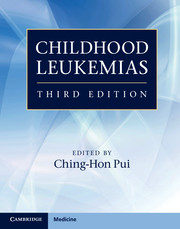Book contents
- Frontmatter
- Contents
- List of contributors
- Preface
- Section 1 History and general issues
- Section 2 Cell biology and pathobiology
- Section 3 Evaluation and treatment
- 12 Pharmacokinetic, pharmacodynamic, and pharmacogenetic considerations
- 13 Acute lymphoblastic leukemia
- 14 Relapsed acute lymphoblastic leukemia
- 15 B-cell acute lymphoblastic leukemia and Burkitt lymphoma
- 16 Acute myeloid leukemia
- 17 Relapsed acute myeloid leukemia
- 18 Myelodysplastic syndrome
- 19 Chronic myeloproliferative disorders
- 20 Leukemias in patients with Down syndrome
- 21 Treatment of adolescents and young adults with acute lymphoblastic leukemia
- 22 Hematopoietic stem cell and natural killer cell transplantation
- 23 Treatment of acute leukemia in countries with limited resources
- 24 Antibody-targeted therapy
- 25 Adoptive cellular immunotherapy
- 26 Gene transfer: methods and applications
- 27 Development therapeutics
- 28 Minimal residual disease
- Section 4 Complications and supportive care
- Index
- Plate Section
- References
21 - Treatment of adolescents and young adults with acute lymphoblastic leukemia
from Section 3 - Evaluation and treatment
Published online by Cambridge University Press: 05 April 2013
- Frontmatter
- Contents
- List of contributors
- Preface
- Section 1 History and general issues
- Section 2 Cell biology and pathobiology
- Section 3 Evaluation and treatment
- 12 Pharmacokinetic, pharmacodynamic, and pharmacogenetic considerations
- 13 Acute lymphoblastic leukemia
- 14 Relapsed acute lymphoblastic leukemia
- 15 B-cell acute lymphoblastic leukemia and Burkitt lymphoma
- 16 Acute myeloid leukemia
- 17 Relapsed acute myeloid leukemia
- 18 Myelodysplastic syndrome
- 19 Chronic myeloproliferative disorders
- 20 Leukemias in patients with Down syndrome
- 21 Treatment of adolescents and young adults with acute lymphoblastic leukemia
- 22 Hematopoietic stem cell and natural killer cell transplantation
- 23 Treatment of acute leukemia in countries with limited resources
- 24 Antibody-targeted therapy
- 25 Adoptive cellular immunotherapy
- 26 Gene transfer: methods and applications
- 27 Development therapeutics
- 28 Minimal residual disease
- Section 4 Complications and supportive care
- Index
- Plate Section
- References
Summary
Introduction
Outcome for young adult patients with acute lymphoblastic leukemia (ALL) is inferior to that of children aged 10 to 14 years and particularly those aged 1 to 9 years at diagnosis. For patients 15 to 24 years of age at diagnosis, 5-year survival has increased steadily from 36.2% in the 1980s to 55.7% in the 1990s. However, there has been no improvement in outcome for patients treated between 2000 and 2005.
Adolescents with ALL are a unique group in that treatment may be provided by either medical or pediatric oncologists. Referral to an oncologist is generally based on the preference of the primary care provider: internists and family practice physicians generally refer patients to medical oncologists while pediatricians refer patients to pediatric oncologists. Adults with ALL have a worse outcome compared with children. The reasons for a worse outcome in adult patients with ALL include a lower incidence of favorable genetic subtypes (t(12;21) or hyperdiploidy), a higher incidence of t(9;22), the presence of comorbidities in older adults, and greater treatment-associated morbidity and mortality. Avascular necrosis of bone is a significant complication of therapy that occurs almost exclusively in adolescents and young adults. There is also a significantly lower salvage rate for older patients who experience a relapse compared with younger patients.
- Type
- Chapter
- Information
- Childhood Leukemias , pp. 520 - 526Publisher: Cambridge University PressPrint publication year: 2012



